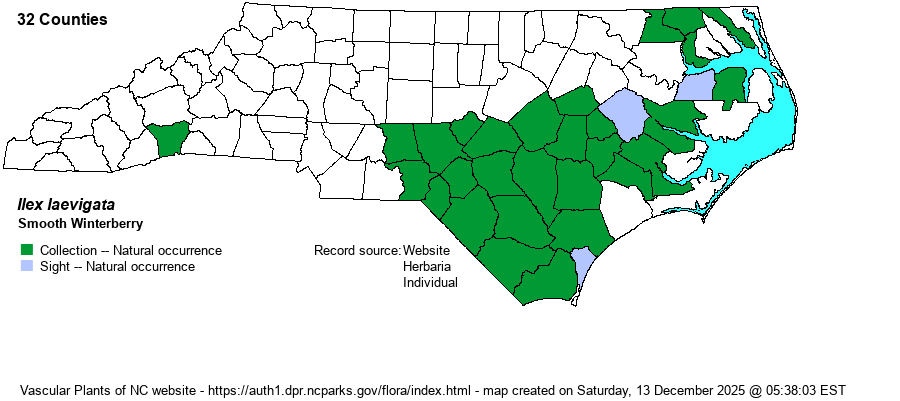| Author | (Pursh) A. Gray | |
| Distribution | Restricted to the Coastal Plain, where widespread in the southern half but sparsely distributed in the northern half. May be legitimately absent in parts of the northern Coastal Plain, such as in the Roanoke River area and in some far eastern counties. One collection record from the southern Mountains (Henderson County) was from the famous, and now destroyed, East Flat Rock bog.
Unlike nearly all species restricted to the state’s Coastal Plain, this species is a Northern one that ranges south only to southern SC. Yet, it occurs north to ME; however, it does not occur in states that do not border the Atlantic Ocean (other than PA and VT).
| |
| Abundance | In the Sandhills region, it is uncommon to frequent; however, elsewhere in the southern part of the Coastal Plain – east to Croatan National Forest – it is uncommon or infrequent. It is rare to uncommon in a few northeastern counties near the VA line. Absent to very rare in counties bordering the Roanoke River and in the southern mountains. | |
| Habitat | This is a species of acidic waters, mostly found in streamhead pocosins in the Sandhills. However, it also occurs in bay forests, margins of larger pocosins, wet boggy or seepy areas, and other places with damp to wet ground and acidic conditions. It is normally outnumbered by the other two “pocosin” hollies – Ilex glabra and I. coriacea – when they are found in the same area. |
| Phenology | Blooms in April and May, and fruits from September to October. | |
| Identification | This is a rather “ordinary-looking” deciduous shrub of medium to fairly tall height, ranging to about 10-12 feet tall. It has alternate leaves that are elliptic and have only very slightly serrated margins, not obvious at a distance; they average 2-2.5 inches long. The leaves are very similar to those of another wetland holly – I. verticillata, but I. laevigata has leaves that are quite shiny above, whereas the other is dull above. In fall, the species is laden with an abundance of rather large scarlet (not red) “berries”; other deciduous hollies tend to have plain or deep red fruit. This is a pocosin species that many people will walk past without recognizing, as it is seldom common anywhere, and as it is often identified by process of elimination. Of the many pocosin shrub/small tree species, it is often about the 10th most often seen along a streamhead pocosin or bay forest margin on a day’s walk – usually well after seeing I. glabra, I. coriacea, Lyonia lucida, Lyonia ligustrina, Clethra alnifolia, Cyrilla racemiflora, Persea palustris, Magnolia virginiana, and several others. | |
| Taxonomic Comments | None
| |
| Other Common Name(s) | None | |
| State Rank | S4 | |
| Global Rank | G5 | |
| State Status | | |
| US Status | | |
| USACE-agcp | FACW link |
| USACE-emp | OBL link |

